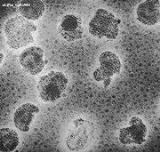
Plasmavirus
Encyclopedia
The Plasmaviridae is a family of bacteriophage
s, viruses that infects bacteria. Virions have an envelope, a nucleoprotein complex, and a capsid. They are 50-125 nm in diameter with a baggy or loose membrane. All species known in this family have been isolated from species in the class Mollicutes
.
Acholeplasma virus L2 is the type species.
This family has been very poorly studied and little is known about these viruses.
-C
content of ~32%. It encodes at least 15 proteins of which at least four are structural proteins embedded in the membrane.
Bacteriophage
A bacteriophage is any one of a number of viruses that infect bacteria. They do this by injecting genetic material, which they carry enclosed in an outer protein capsid...
s, viruses that infects bacteria. Virions have an envelope, a nucleoprotein complex, and a capsid. They are 50-125 nm in diameter with a baggy or loose membrane. All species known in this family have been isolated from species in the class Mollicutes
Mollicutes
The Mollicutes are a class of bacteria distinguished by the absence of a cell wall. The word "Mollicutes" is derived from the Latin mollis , and cutis . They are parasites of various animals and plants, living on or in the host's cells. Individuals are very small, typically only 0.2–0.3 μm in size...
.
Acholeplasma virus L2 is the type species.
This family has been very poorly studied and little is known about these viruses.
Genome
The genome is condensed, non segmented and consists of a single molecule of circular, supercoiled double-stranded DNA, 12 kilobase pairs in length. The genome has a rather high GGuanine
Guanine is one of the four main nucleobases found in the nucleic acids DNA and RNA, the others being adenine, cytosine, and thymine . In DNA, guanine is paired with cytosine. With the formula C5H5N5O, guanine is a derivative of purine, consisting of a fused pyrimidine-imidazole ring system with...
-C
Cytosine
Cytosine is one of the four main bases found in DNA and RNA, along with adenine, guanine, and thymine . It is a pyrimidine derivative, with a heterocyclic aromatic ring and two substituents attached . The nucleoside of cytosine is cytidine...
content of ~32%. It encodes at least 15 proteins of which at least four are structural proteins embedded in the membrane.

